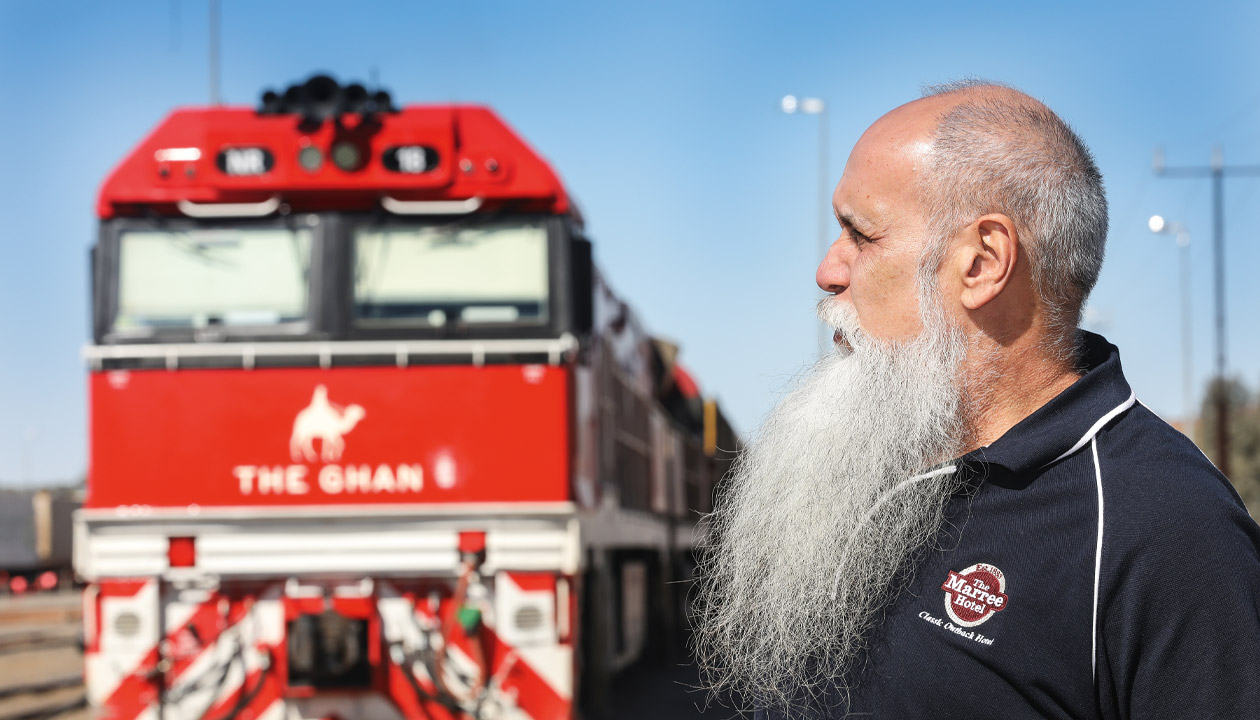The legendary Ghan commemorates its 90th birthday in style on a three-day odyssey across Australia.
Story Mark Muller Photo Russell Millard
Graham Dadleh runs a hand down his thick beard and fans through a collection of photos on the table in front of him. Among them are pictures of turbaned men, camels, trains, women, children, and more trains – records of the evolving history of his family, and of Australia. Out the window the central desert scenery passes by. The rocking of the carriage is relaxing and the conversation drifts through the decades to a time when most things transported through this country were carried on the backs of camels. Graham is the great-grandson of Dadleh Balooch and Moosha Balooch, two of thousands of men from Central Asia – known collectively as ‘Afghans’ – who came to Australia to drive camels in the 19th century.
As technology developed, many of these cameleers turned their hands to building the railway that today stretches almost 3000km from Adelaide to Darwin. The most famous train to travel these rails now honours their name: the Ghan. 2019 marks the 90th anniversary of the first Ghan train, and Graham is travelling the route to commemorate the occasion with his aunt Sue. But Graham is more than a passenger; he drove the special birthday train on its first leg from Port Augusta, where he lives. He has worked the trains for almost 40 years, and is quietly proud to be continuing in the tracks of his ancestors. “It’s always special to drive the Ghan,” he says. “I love trains, but this one is very close to our hearts.” Graham was born in Marree and moved to Port Augusta as a boy when his father’s railway job took the family to the southern port. He joined the railways himself at the age of 16, “but when we talk about home, it related to Marree,” he says.
While the first official Ghan left Adelaide in 1929, its origins lie further back in time. Work began on a rail link between Port Augusta and the Stuart settlement – today’s Alice Springs – in 1877. Those tracks made it as far as Oodnadatta before work was halted in 1891. The spike mauls were taken up again in 1926, with the track reaching Alice Springs for the first time in 1929. In 1980 the original line, which was laid along the overland telegraph track, was converted to a standard gauge and shifted to the west. It was always intended that it would go all the way to Darwin, but expense and difficulty conspired to see this dream unfulfilled until the 21st century. In 2001 work recommenced, and in 2004 the remaining 1420km of the transcontinental line to Darwin was opened. The estimated construction cost of this final leg stands at $1.3 billion.
The standard story will tell you that the Ghan was named simply to honour Graham’s forebears, but there is a deeper line that leads to a more sardonic derivation. This is laid out by the Pichi Richi Railway Preservation Society, referencing the Islamic Museum of Australia’s Boundless Plains: The Australian Muslim Connection:
“During the cool months of 1923 the South Australian Railways decided to shorten the time taken by trains for passengers and perishable freight between Adelaide and Oodnadatta. Before this time, trains had stopped overnight at stations en-route ... after 1923, a sleeping car was provided and the train rescheduled to continue without stabling overnight. On 30 August 1923 the inaugural through passenger train ... ran from Terowie to Oodnadatta. It was on this trip that the name the Ghan has its origin. A large crowd of local people gathered at Quorn station to witness the arrival of the new train with its sleeping car. When the train pulled into Quorn yard it was almost dusk. An Afghan passenger wasted no time in getting off the train and sprinting to a quiet corner of the yard where he could kneel to face Mecca and recite his ritual evening prayers. A railwayman made the joking remark that if he was the only passenger on the train it should be called the Afghan Express. Apparently the name proved popular and was adopted immediately, later being shortened to the Ghan Express, and then to the Ghan.”
This story excerpt is from Issue #128
Outback Magazine: Dec/Jan 2020










